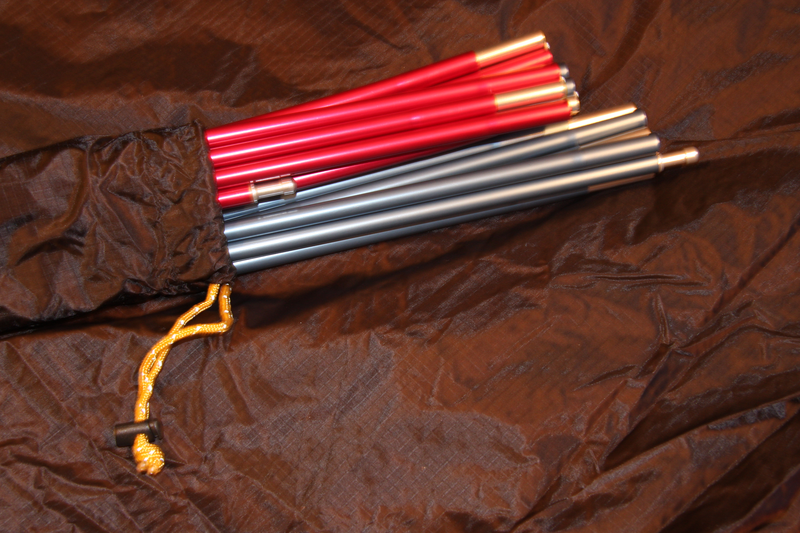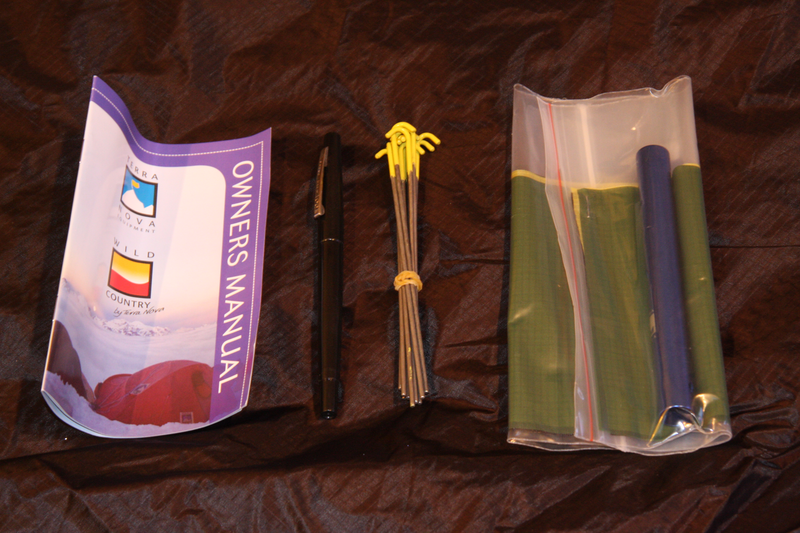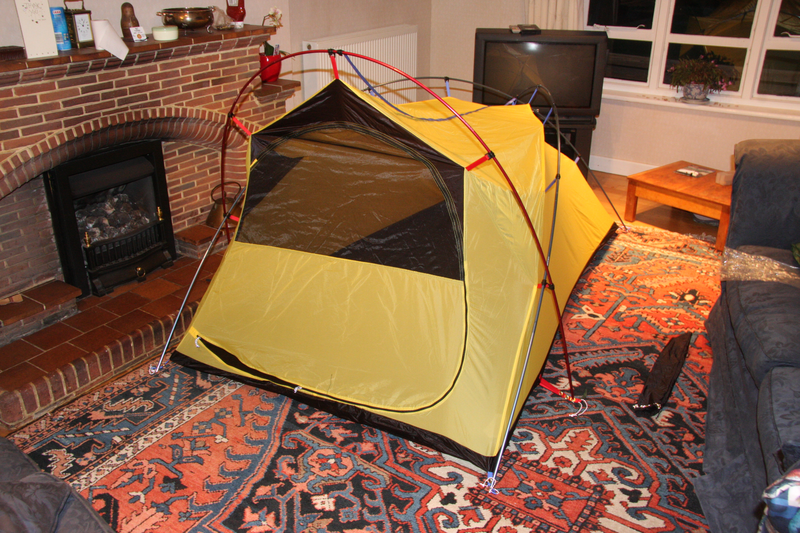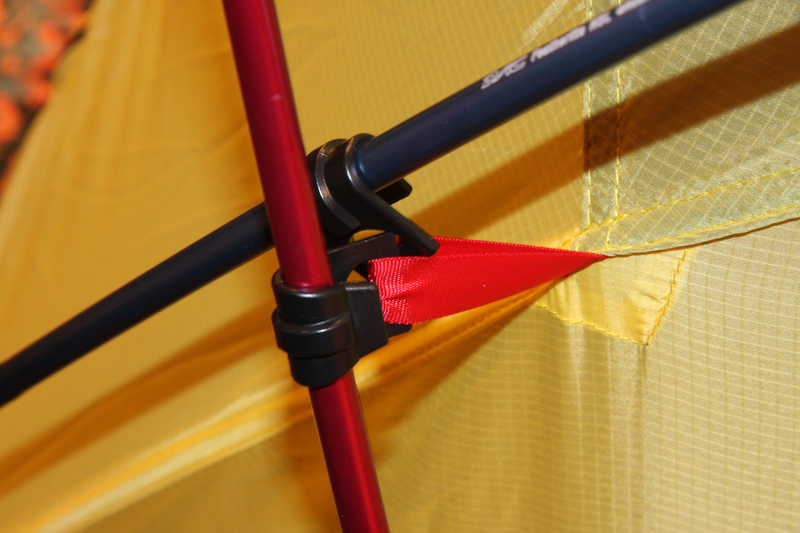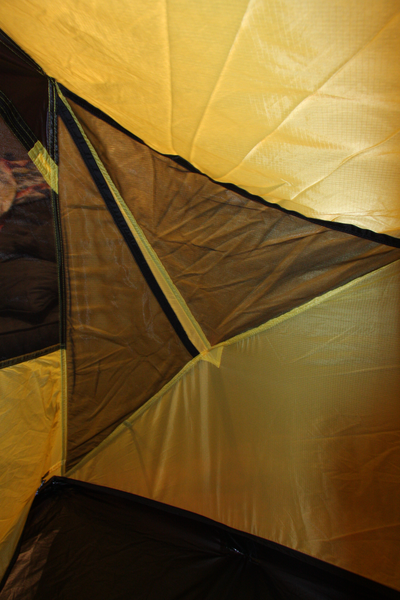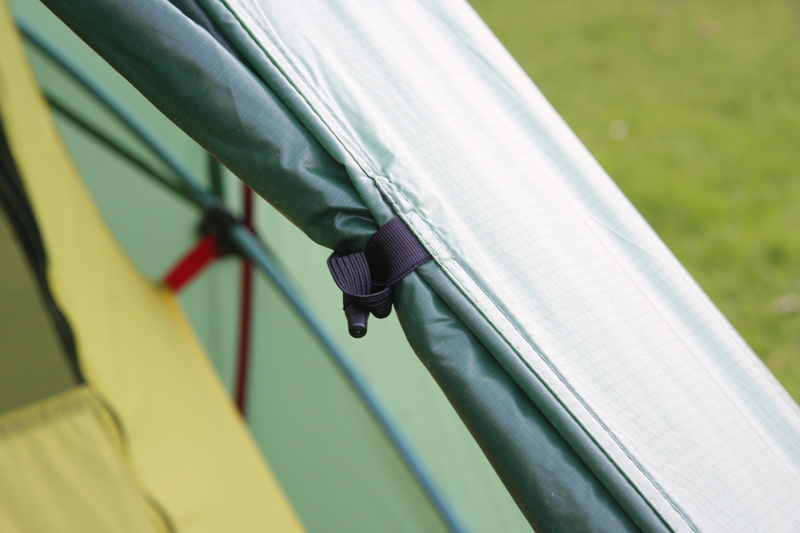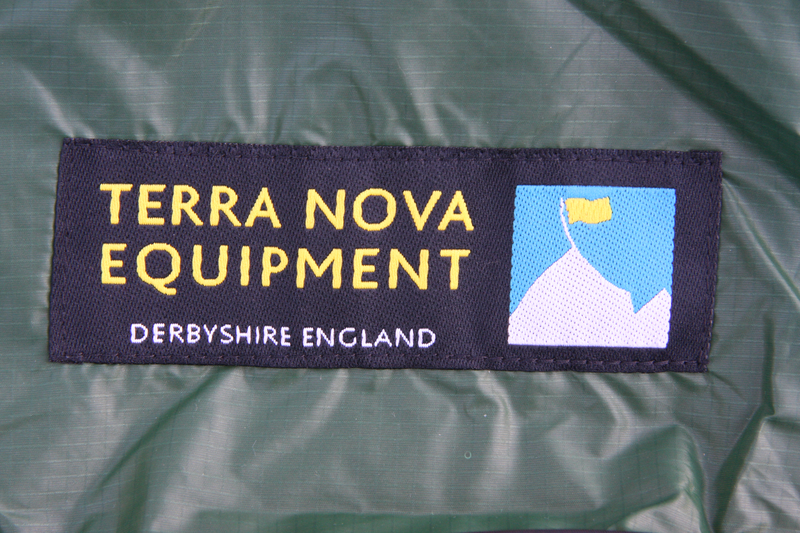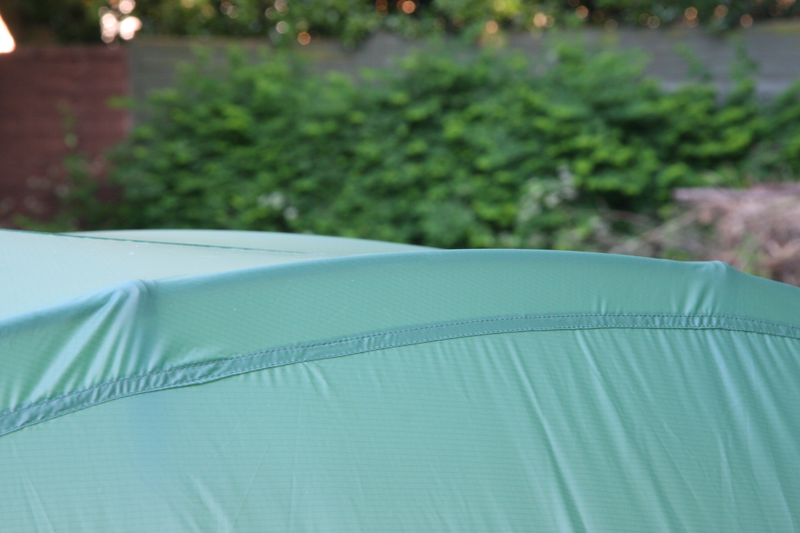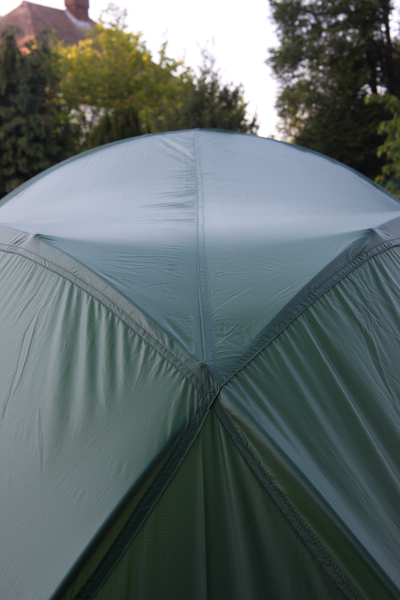Tera Nova Voyager Superlite 2009
| Posted: | 2009-05-23 21:48 |
|---|---|
| Tags: | Outdoors |
I first used a Tera Nova Voyager during my Duke of Edinburgh Award expeditions for Silver and Gold. had a blue Lichfield Beaver 2/3 as a child.
I remember the old Voyager as being rather heavy though (but much lighter than the Vango Force 10s we used for DofE Bronze). The old Voyager was a great tent though and I borrowed one once or twice to go on cycle touring trips in France and Derbyshire with Nathan. I always considered a semi-geodesic design to be the best for space, stability and weight and I remember feeling quite smug as a child when I saw other people in their single hoop tents.
Since then I've been talking about buying a tent so much that it has become something of a joke. The thing is that most of my friends now prefer hostels, B&Bs or even hotels so I really haven't had a good excuse to buy a tent (on other occassions I've been able to borrow one). Recently though, Darwin and Clare have been going on a few surfing trips recently and have been camping overnight. There is also some talk of a trip to the High Atlas in Morocco and I'd still love to cycle across France, soemthing I've been threatening to do for years too. So, today, after over a decade of waiting, I've finally bought a tent!
Considering the Laser, Laser Competition and Laser Photon
Before I started looking I thought I'd think quite honestly about what I would likely use it for. Here's what I came up with:
Need a tent for:
- Cycle touring - trip across France, staying in campsites or in fields
- Weekend trips to the peak district or lake district
- Surfing or climbing trips where we stay in camp sites in UK or Europe
- Festivals
- As an emergency stand in on long hikes in case a hostel or mountain hut is closed
- As an emergency backup for walks in the alps/high atlas/dolomites/iceland
I used to be the sort of person who would take anything and everything backpacking (probably partly to do with the love of gadgets I used to have) and I would have a huge pack as a result. Now I really like the idea of travelling light and am the sort of person that would rather learn to use a limited set of kit properly than to carry more than I needed.
I'd heard great things about the Tera Nova Laser Competition and the Hilleburg Atko and found the idea of a super-lightwight one person tent very appealing. There's a good review of the Laser Competition here <http://v-g.me.uk/GearTech/GearTech-Equipment-LaserCompRV.htm>_ and it look's like Mark Beaumont used something similar for his around the world trip (I went to one of his first lectures at OUEC when he got back).
Smitten by the idea (and completely forgetting how sumg I'd felt in the past when I'd seen single hoop designed buffetted in the Scottish wind) I seriously considered the Laser Competition but was told that it was no longer made (is this actually true?). Instead I considered the Laser Photon which weighs even less at under 800g. When you pick it up it is just amazing but in reality if I were doing anything serious I just don't think I could trust it. Tera Nova are quite clear that it is really for mountian marathons and the rules normally state you have to sleep in a two-skin tent (maybe if the rules allowed bivi bags the tent would never have been designed) and that it isn't really designed for backpacking. One forum post made the point that you might be willing to take a risk in such circumstances because there might be an emergency team to help you out if you have a problem. For the more ambitious scale of my expected use it just sounded like too much of a comprimise.
What really put me off the Laser Photon was these thoughts:
- Even 800g is too much to carry to just use as an emergecny, and in any kind of emergency involving bad weather it wouldn't be much good anyway
- Having to take ear plugs because it makes so much noise in the wind doesn't sound appealing
But the real killer was this:
- It's one thing if the tent fails under extreme conditions on a hill but realistically most of my use for it will be in campsites and I would be totally embarrassed if I had some really bad weather in a campsite and the tent wasn't up to the job there
Since I couldn't be totally confident it would be up to the job of working in a campsite in bad weather that was really the end of my enthusiasm for it. Fundamentally the Laser Photon seemed a specialist bit of kit and however much I wanted it to be a good all round backpacking tent, it seems to me that that just isn't what it is designed for.
Another choice is the 2009 Laser which has a door each side and is designed for two people rather than one plus a close friend. I don't need two doors and at 1.2Kg though I couldn't see any advantage over the 2009 Voyager Superlite.
The Voyager Superlite
After my head had regained control over my heart I realised that I needed something a bit more sturdy than the Laser. Since I'd liked the Voyager tent so much as a child I thought I'd see how it had a evolved in the intervening decade. I was delighted to see that the great design had remained pretty much the same but that their was a super-light "superlite" version weighing under 1.5 Kg (bear in mind a bivi bag can weight 500g on its own!). Now in any serious backpacking I'd do I'd expect to be going with at least one other person and since the Superlite Voyager is a two person tent I'd only be carrying half the weight anyway. On that basis the Voyager Superlite is less per person than the Laser Photon anyway (unless you cram two people into it) and it means I can have a spacious sturdy campsite tent the rest of the time. Pretty sensible all in all.
Before I buy anything I usually try to find the worst reviews I can for it on the basis that if I can live with the worst case I probably won't be too disappointed. In the case of the Superlite Voyager, the worst reveiw is this post where it is described as a "compromised dog's breakfast of a tent": Terra Nova Superlite Voyager Tent: why it's crap. In it the author complains about:
- the inner first pitching
- puddles forming
- leaky seams
- minimalist titanium pegs in
- awful porch flap design
- nowhere near big enough for two people to use as a long term shelter
I asked in the Outdoor shop about the seams and even though it isn't mentioned explicitly in the short documentation which comes with the tent it appears you are supposed to seal the seams yourself. I'll give Tera Nova a ring and check with them but if the author of the post didn't do that it would explain the leaks. The rest of his comments all seem fair enough but are either not insurmountable or would be the same with any similar tent. All in all I'm not put off. The 2009 model of the Superlite Voyager is also 300g lighter than the previous Superlite Voyager he reviewed so that should give it bonus points.
This thread has comments about the Voyager vs the old Superlite Voyager. There are also some concerns that the flysheet ends up being flat in one place so that a puddle could form. Other poster's dismiss the idea though and the 2009 model has a different shape with a higher roof so I think this would be avoided anyway.
There are also many positive reviews and it is currently the top rated tent at this site:
- http://drw.me.uk/RedYeti/2009/04/29/the-terra-nova-superlite-voyager-toughened-up/
- http://blog.cheaptents.com/terra-nova-voyager-superlite-review/
- http://www.livefortheoutdoors.com/Gear-Reviews/Search-Results/Tents/Terra-Nova-Voyager-Superlite/
- http://www.terra-nova.co.uk/Activity/Backpacking_and_Camping/Voyager_Superlite_Green.html?view=accessories
- http://www.terra-nova.co.uk/downloads/VoyagerSuperliteTGOJuly2006.pdf
One point to note is that the Superlite Voyager is slightly smaller than the Voyager. I can still just about lie down in it in a sleeping bag without my heador feet touching the sides at all but if I were two inches taller I'm not too confident I could (I'm 5"11). Still there is mesh one end and the door the other so I wouldn't think touching the mesh would be too much of a big deal anyway.
Getting It Home
I bought the tent for £290 (SRP £330 apparantly although £290 seems the standard price) from The Outdoor Shop in Stony Stratford where I also bought the rucksacs, sleeping bag, water proof jacket, climbing gear and just about every other piece of outdoor equipment I own. They are very knowledgeable and sell good quality equipment.
On unpacking it in the shop the flysheet felt very similar to the material of the Laser Photon. It is incredibly thin and feels as though anything even slightly sharp would rip right through it but I'm sure it is stronger than it looks. Also I'm yet to be convinced by the 1g titanium tent pegs - I've used toothpicks that looked more substantial and you can see from the photo below that 12 of them put together are barely bigger than an ordinary biro. Just in case there were problems I also bought 6 carbon fibre pegs too. I wsa advised not to hit them with a hammer or they shatter and to be careful pulling them out because if they snap they are very good at splintering and apparantly the carbon fibre splinters are posionous. If those don't work out either I'll just go back to alloy pegs.
The first time you pitch the inner you almost have to bend the poles into shape. The instructions say not to worry if the poles take on a natural shape over time but I felt slightly nervous the first time I put the red pole for the front of the tent in place because the poles don't appear super-strong and it seemed to take more force than I expected. Once in though they are fine.
The tent itself has some nice features. There are three mesh pockets on the inner, half way up just inside the door, two on the right side as you look out of the tent and one on the left. There is a mesh panel at the end of the rear for ventilation and the top of the door is made of mesh (it isn't a dual mesh and fabric door like the original Voyager) so that you can get air in there too.
The inner fabric again feels thin but the groundsheet feels extrodinarily thin. I'd be worried about catching a sleeping bag zip on it and tearing it. To put it in perspective I pitched it in my lounge the first time (in case it was too small and I needed to take it back) and I felt a grain of cooked rice between me and the carpet! When I first use this for real I think I'm going to put my roll mat under the groundsheet rather than on top of it. I might look at buying a groundsheet protector too.
The other thing to mention is that the main zip is a lot smaller than I expected and again I think I'm going to have to be quite careful not to damage it.
Pitching
Update 24th May 2009.
There is one small loop on the left side of the tent as you face the front which looks as though you might be supposed to thread each one of the blue poles through it. You don't, it is there so you can tie the left panel of the door back. Unlike in the pitching guide video there is no such tag on the right hand side. Also the flysheet door only has a zip one side so you can't roll the door up vertically. Instead you roll it to the right as you look at it and there are two sets of tabs. I'm not sure I like this approach as much but presumably it all saves weight. The zip starts off looking broken because it is closed up all the way and just above the top zip, the teeth don't meet properly. If you just move the zips to the top it all works fine again though.
Also, the flysheet has the same eyelet tapes as the inner in the same colours and I wasn't clear whether the poles were supposed to go into these or not. Looking at the video again you do which is good because there wouldn't have been enough pegs otherwise (there are only 12). As it happens there are 13 places which need a peg (two of them are guy ropes) so why are there only 12 pegs? Also, although I'd read someone else doing this and thought they were an idiot, I managed to lose a peg whilst pitching the tent in my back garden. It sounds ridiculous but they are so small that unless you are really very careful they can go walkabout. Because they are so thin though they are actually very easy to put into the ground and they seem pretty strong. Lucky I bought some spare pegs when I bought the tent though.
On my tent the tenstion strap isn't under tension like in the video but I don't expect this to be a problem. All the pegging points have elastic cord on them so it is clear where the pegs go. The flysheet door pegs have two loops per peg (one for each side of the door). There are also two guy lines.
The roof does look slightly flat at one point from the side but has a slope from the front to the back. I did the "football test" and couldn't get it to stay anywhere despite the fact its weight depressed the fabric slightly so I hope its OK. Only time will tell though! I'm staying in it tonight so if it rains I might find out.
Summary
All in all I'm extremely pleased with my choice so far and can't wait to get it out for real. It is clear that the materials used in this tent are a lot thinner than the Voyager I used 13 years ago and my natural instinct is to assume that they aren't as strong but because of the technical improvements that may not necessarily be the case. Eevn if the fantastic weight savings mean I have to look after the tent a bit more carefully than I would have had to with the original Voyager and I'll have to ask whoever shares the tent with me to treat it gently too, that still seems a extrememly reasonable price to pay for not having to lug around so many kilograms of weight. I'm optimistic that the tent itself we will be as sturdy and as safe a shelter as the old Voyager I used to love and it will certainly be a lot more sturdy than the Laser Photon. It is rated as a 4 season tent after all.
I'll try to update this page as I get more experience using the tent in different circumstances.
Further Info
Here's the pitching guide for the Voyager Superlite (which applies to the 2009 model too but the poles and tapes are colour-coded red and blue, red goes at the front) and here's the fact sheet
Other Pages I Read
- http://www.terra-nova.co.uk/Downloads/Factsheet/2009%20voyager.pdf
- http://www.outdoorsmagic.com/forum/forummessages/mps/UTN/18891/dt/4/URN/5/srchdte/0/cp/2/v/8/sp/
- http://www.outdoorsmagic.com/forum/forummessages/mps/UTN/20592/dt/4/URN/5/srchdte/0/cp/3/v/1/sp/
- http://www.petesy.co.uk/?p=97
- http://www.backpackgeartest.org/reviews/Shelters/Tents/Terra%20Nova%20Laser%20Competition/ (Three different reports linked from this page)
- http://www.livefortheoutdoors.com/Gear-Reviews/left-hand-nav/Tents/
- http://www.terra-nova.co.uk/Downloads/Factsheet/2009%20Superlite%20voyager.pdf
- http://v-g.me.uk/GearTech/GearTech-Equipment-LaserCompRV.htm
- http://www.crazyguyonabike.com/doc/page/?o=3Tirr&page_id=92628&v=2j
- http://www.outdoorsmagic.com/search/forummessages/voyager-superlite/threadid/11923
- http://www.andyhowell.info/trek-blog/2007/05/30/review-terra-nova-superlight-solar-22/
- http://www.outdoorsmagic.com/news/article/mps/uan/4245
- http://www.buachaille.com/p648-2-18/2-Man-Tents/Terra-Nova-Laser.html
- http://www.livefortheoutdoors.com/Gear-Reviews/Search-Results/Tents/Terra-Nova-Laser-Competition-2009/
- http://forum.ctc.org.uk/viewtopic.php?f=16&t=18215
Tip
When searching Google for information on tents, add the word forum, that way you avoid all the price comparison sites with no information that tend to make up the bulk of results. Tent and outdoor forums and people's personal blogs tend to have the best information.

